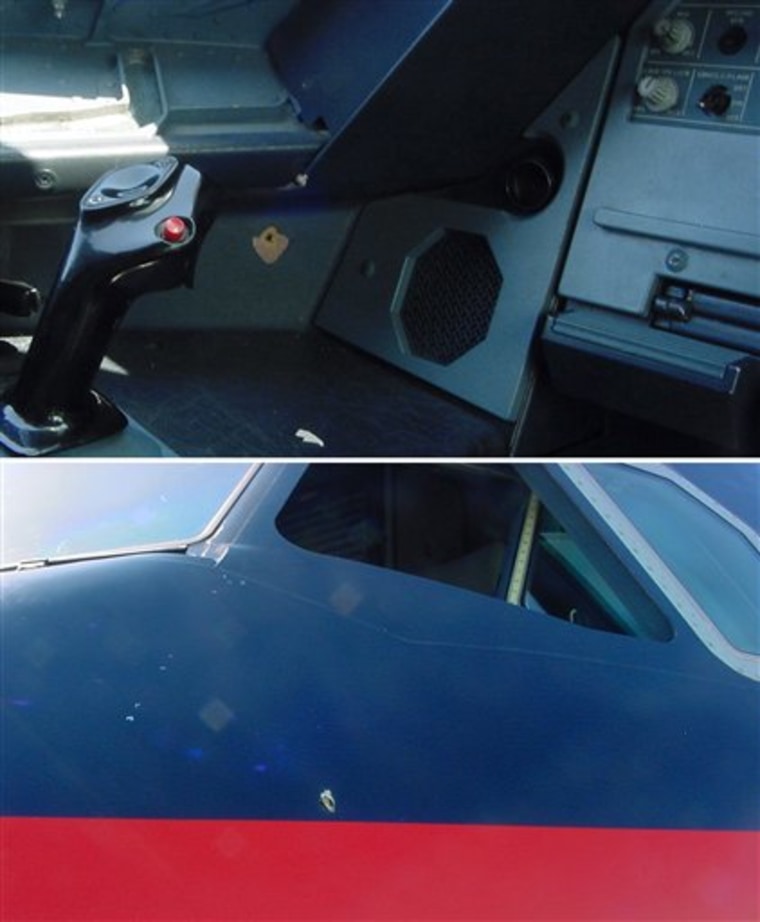A US Airways pilot whose gun fired inside a cockpit said he was trying to stow the weapon as the crew got ready to land, according to a police report released Wednesday.
The pilot didn't tell air traffic control about the shooting or say the bullet had punctured the cockpit until after the plane landed safely at Charlotte-Douglas International Airport on Saturday, the report said. Photos obtained by The Associated Press show a small exit hole on the plane's exterior below the cockpit window.
US Airways Tower Supervisor Nathan Gundlach told police that when he arrived the pilot was on the phone with the Transportation Security Administration. Gundlach contacted US Airways about the in-flight shooting, but police were not notified until an hour later.
"When I questioned Mr. Gundlach about the delay in airport police being notified, Mr. Gundlach apologized and took full responsibility," an airport police officer wrote in the report.
The Federal Aviation Administration also wasn't told immediately about the incident.
"The first we knew about it was when TSA contacted us," FAA spokeswoman Laura Brown said.
US Airways spokeswoman Andrea Rader declined to comment Wednesday, but airline officials have said the accidental discharge did not endanger the 124 passengers and five crew members on board. Greg Alter of the Federal Air Marshal Service said Wednesday it remained under investigation.
‘Fly first, communicate second’
Airline experts said the pilot, who was certified to carry the weapon on board, may have reacted appropriately after the accidental discharge.
"If something happens in the air that's not an emergency that's changed the course of action of the aircraft, the priority is to land the airplane," said William Brogan, an aviation expert at Lewis University near Chicago. "It's fly first, communicate second."
Retired Army pilot Joseph Gutheinz Jr., an investigative consultant in NASA and FAA cases, said the gun should have been stowed safely.
"As an agent, I had my weapon in a shoulder holster when I flew and did not touch it in flight. If for some reason I did have to remove it, it would not be in the air while moving and where I was subject to the impact of turbulence," said Gutheinz, a criminal defense attorney in Houston.
The pistol discharged shortly before noon Saturday aboard Flight 1536 from Denver to Charlotte, as the Airbus A319 was at about 8,000 feet and about 10 minutes from landing.
The unidentified pilot, who has been taken off duty during the investigation, was part of the federal flight deck officer program created after the Sept. 11, 2001, terrorist attacks.
It was the first time a pilot's weapon has been fired on a plane since the certification program was created after the Sept. 11, 2001, terrorist attacks, Alter said. More than 10,000 flight deck officers, either captains or first officers, have taken part in the training — but about 120,000 pilots fly commercially in the U.S., according to the Air Line Pilots Association, the union that represents more than 61,000 pilots at 43 airlines.
Program emphasizes gun safety
The weeklong program is intense, Alter said. Pilots must volunteer and pass a psychological test before traveling to the federal Law Enforcement Training Center in Artesia, N.M.
They're given a .40-caliber semiautomatic H&K USP, the same weapon issued to all people eligible to carry guns in the cockpit. The pilots spend a week learning how to shoot and handle the gun safely and about legal issues related to firing a weapon.
"Gun safety is the crux of this course," Alter said.
The program, which operates most of the year, can handle about 48 trainees a week. Most of the time the classes are nearly full, he said.
The TSA spends $4,800 per person to cover the price of the gun and course, Alter said. But that doesn't cover transportation or lodging costs, which could be a reason why more pilots don't participate.
Capt. Bob Hesselbein, chairman of the pilots union, said some airlines are better than others about encouraging pilots to volunteer for the program, but he wouldn't elaborate. Most pilots support the concept of the program, he said.
The plane will be grounded in Charlotte for several more days until the FAA approves the repairs.
